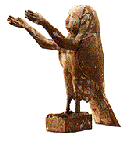Tomb Robbers and Religion
Winer, Bart. Life in the Ancient World, Random House Inc. NY, NY 1961. pp. 57-58, et. al.

The pyramid was supposed to protect the pharaoh's body from the Nile, wild animals, and robbers. The Egyptians believed that they were born with a double, another self, called the ka. When the body died a soul called the ba flew out, sent a life spark through the ka, and then traveled to the other world. Now the ka could go in and out of the tomb and dine on the food and drink left at the temple near the tomb. But, it had to return to the body.
If the body was destroyed, the Egyptians feared that their ka would be destroyed, too. So they invented embalming, to preserve the dead body in unguents and linen bandages. But they knew that accidents happened and that the best mummies disintegrated. The pharaoh therefore had a model body--a stone statue of himself--placed in the tomb.
At first, the pharaoh made a contract with a temple to supply him with food and drink for centuries to come. One pharaoh gave twelve towns to a temple to guarantee a steady supply. But the priests were human, and within a hundred years the contract was forgotten. To guard against this, the pharaoh also provided himself with model food--details of his food and drink were also inscribed on tombstones.

The pharaoh never had to work in heaven, but his courtiers were afraid that they might have to plow, spin, and cook in the hereafter. To protect themselves, they had artists fashion model servants and tools which were placed in their tombs. these were called shawabty figures or ushabty, which means "answerer." When a courtier in the hereafter needed something, he called on one of these models to do the work. Spell 6 of The Book Of The Dead instructs the Shawtaby as follows:
O Shawtaby, If 'the deceased' be summoned
To do any work which has to be done in the realm if the dead
To make arable the fields,
To irrigate the land
Or to convey sand from East to West;
"Here I Am", you shall say, "I Shall Do It".
Pharaohs and courtiers wrote dire threats on their tomb walls. They built passages leading to dead ends. Tons of stone sealed the burial chamber. The entrance to the pyramid, high up on the wall face was so carefully blocked that it couldn't be detected. Yet every protective device proved in vain. Robbers managed to steal the treasures, even the gold and jewel-laden bodies were taken out of all the pyramids and most of the tombs. These were stolen not In modern times but in ancient times. Often the mason who had built the tombs later robbed them. While building a new tomb, they also tunneled into an old one next door.
Digg This!
![]() Del.icio.us
Del.icio.us
![]() Stumble Upon
Stumble Upon
